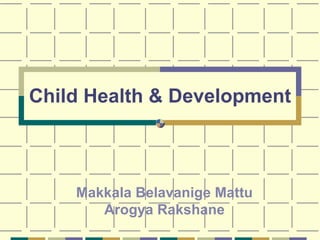Makkala belavanige mattu arogya rakshane
•Télécharger en tant que PPT, PDF•
3 j'aime•6,207 vues
Signaler
Partager
Signaler
Partager

Recommandé
Contenu connexe
Tendances
Tendances (16)
Unit one AQA A Psychology Attachmet Key Studies to know

Unit one AQA A Psychology Attachmet Key Studies to know
En vedette
En vedette (20)
Similaire à Makkala belavanige mattu arogya rakshane
Similaire à Makkala belavanige mattu arogya rakshane (20)
Lecture 10:Psychological development of children Dr.Reem AlSabah

Lecture 10:Psychological development of children Dr.Reem AlSabah
1- What do you see as the most important things that parents can

1- What do you see as the most important things that parents can
Assignment DetailsOpen DateApr 2, 2018 1205 AM.docx

Assignment DetailsOpen DateApr 2, 2018 1205 AM.docx
11The Developing Personality Emotions and Temperament© Ra.docx

11The Developing Personality Emotions and Temperament© Ra.docx
Plus de Shama
Plus de Shama (16)
GERD (gastroesophageal reflux disease) in children

GERD (gastroesophageal reflux disease) in children
Dernier
Dernier (20)
Kodo Millet PPT made by Ghanshyam bairwa college of Agriculture kumher bhara...

Kodo Millet PPT made by Ghanshyam bairwa college of Agriculture kumher bhara...
This PowerPoint helps students to consider the concept of infinity.

This PowerPoint helps students to consider the concept of infinity.
Interdisciplinary_Insights_Data_Collection_Methods.pptx

Interdisciplinary_Insights_Data_Collection_Methods.pptx
Python Notes for mca i year students osmania university.docx

Python Notes for mca i year students osmania university.docx
Basic Civil Engineering first year Notes- Chapter 4 Building.pptx

Basic Civil Engineering first year Notes- Chapter 4 Building.pptx
Salient Features of India constitution especially power and functions

Salient Features of India constitution especially power and functions
Fostering Friendships - Enhancing Social Bonds in the Classroom

Fostering Friendships - Enhancing Social Bonds in the Classroom
Exploring_the_Narrative_Style_of_Amitav_Ghoshs_Gun_Island.pptx

Exploring_the_Narrative_Style_of_Amitav_Ghoshs_Gun_Island.pptx
Beyond_Borders_Understanding_Anime_and_Manga_Fandom_A_Comprehensive_Audience_...

Beyond_Borders_Understanding_Anime_and_Manga_Fandom_A_Comprehensive_Audience_...
HMCS Max Bernays Pre-Deployment Brief (May 2024).pptx

HMCS Max Bernays Pre-Deployment Brief (May 2024).pptx
Makkala belavanige mattu arogya rakshane
- 1. Makkala Belavanige Mattu Arogya Rakshane Child Health & Development
- 4. Fig. 3.1 This image, made with a scanning electron microscope, shows several pairs of human chromosomes. (Colors are artificial.) © Biophoto Associates/Science-Source/Photo Researchers
- 5. Fig. 3.2 (Top left) Linked molecules (organic bases) make up the “rungs” on DNA’s twisted “molecular ladder.” The order of these molecules serves as a code for genetic information. The code provides a genetic blueprint that is unique for each individual (except identical twins). The drawing shows only a small section of a DNA strand. An entire strand of DNA is composed of billions of smaller molecules. (Bottom left) The nucleus of each cell in the body contains chromosomes made up of tightly wound coils of DNA. (Don’t be misled by the drawing: Chromosomes are microscopic in size and the chemical molecules that make up DNA are even smaller.)
- 6. Fig. 3.3 Gene patterns for children of brown-eyed parents, where each parent has one brown-eye gene and one blue-eye gene. Since the brown-eye gene is dominant, 1 child in 4 will be blue-eyed. Thus, there is a significant chance that two brown-eyed parents will have a blue-eyed child.
- 15. Fig. 3.5 Infant imitation. In the top row of photos, Andrew Meltzoff makes facial gestures at an infant. The bottom row records the infant’s responses. Videotapes of Meltzoff and of tested infants helped ensure objectivity. (Photos courtesy of Andrew N. Meltzoff.)
- 16. Fig. 3.7 Motor development. Most infants follow an orderly pattern of motor development. Although the order in which children progress is similar, there are large individual differences in the ages at which each ability appears. The ages listed are averages for American children. It is not unusual for many of the skills to appear 1 or 2 months earlier than average or several months later (Frankenberg & Dodds, 1967; Harris & Liebert, 1991). Parents should not be alarmed if a child’s behavior differs some from the average.
- 18. Fig. 3.8 Psychologist Carolyn Rovee-Collier has shown that babies as young as 3 months old can learn to control their movements. In her experiments, babies lie on their backs under a colorful crib mobile. A ribbon is tied around the baby’s ankle and connected to the mobile. Whenever babies spontaneously kick their legs, the mobile jiggles and rattles. Within a few minutes, infants learn to kick faster. Their reward for kicking is a chance to see the mobile move (Hayne & Rovee-Collier, 1995). © Michael Newman/PhotoEdit
- 20. Fig. 3.9 The traditional view of infancy holds that emotions are rapidly differentiated from an initial capacity for excitement. (After K.M.B. Bridges, 1932. From “Emotional Development in Early Infancy.” Reprinted by permission of the Society for Research in Child Development.)
- 21. Fig. 3.10 Infants display many of the same emotional expressions as adults do. Carroll Izard believes such expressions show that distinct emotions appear within the first months of life. Other theorists argue that specific emotions come into focus more gradually, as an infant’s nervous system matures. Either way, parents can expect to see a full range of basic emotions by the end of a baby’s first year. Over the first 2 years, children become increasingly active in initiating emotional exchanges with parents (Grolnick, Cosgrove, & Bridges, 1996).
- 24. Fig. 3.17 Children under age 7 intuitively assume that a volume of liquid increases when it is poured from a short, wide container into a taller, thinner one. This boy thinks the tall container holds more than the short one. Actually each holds the same amount of liquid. Children make such judgments based on the height of the liquid, not its volume.
